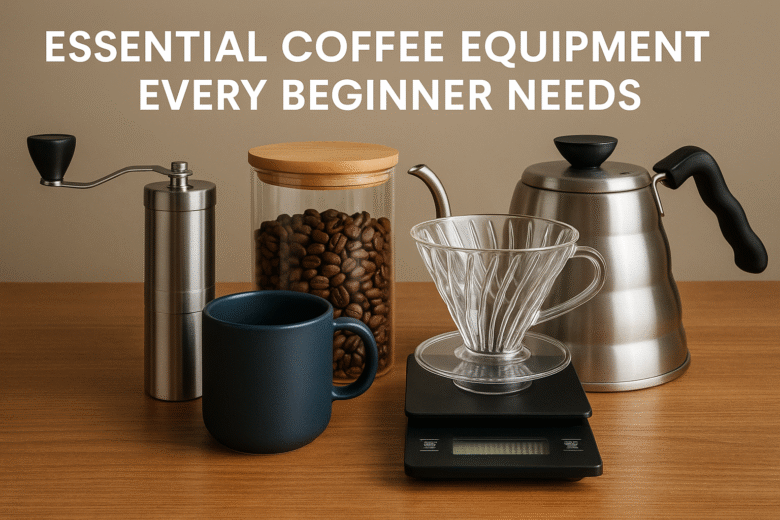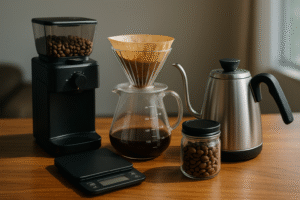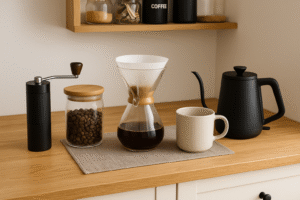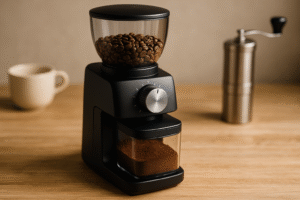Getting into the world of coffee can feel overwhelming at first. There are countless tools, machines, and brewing methods out there. But you don’t need a professional bar setup to make great coffee at home.
With a few essential pieces of equipment, any beginner can start making high-quality coffee and build a foundation to grow their skills over time.
This guide will help you understand what tools are truly necessary and how they impact your brewing experience.
Why Coffee Equipment Matters
Great coffee doesn’t come from beans alone. The tools you use affect everything—from flavor and aroma to texture and strength.
Precision in temperature, grind size, and brewing time can turn a good cup into an exceptional one. The right equipment gives you control and consistency.
Investing in the basics allows you to experiment and improve your technique without needing to visit a café for every cup.
The Grinder: Your First Priority
If you’re starting from scratch, your most important investment is a coffee grinder. Freshly ground beans make a huge difference in taste.
Pre-ground coffee loses flavor quickly. Grinding your own beans preserves their complexity and freshness.
Look for a burr grinder, not a blade grinder. Burr grinders crush beans evenly, allowing for consistent extraction. Blade grinders chop beans unevenly, creating a mix of fine and coarse particles.
Manual burr grinders are affordable and compact. Electric burr grinders offer speed and convenience.
The Scale: Precision Brewing
Coffee is a science as much as an art. Using a kitchen scale helps you measure coffee and water accurately, ensuring balance in every cup.
Eyeballing measurements leads to inconsistency. Using grams instead of scoops makes it easier to repeat recipes and troubleshoot results.
A basic digital scale is enough. Look for one that measures in 0.1g increments and fits your brewing gear.
This simple tool can dramatically improve your coffee without adding complexity.
The Kettle: Control Your Water
A good kettle ensures the right water temperature and flow rate, especially for manual brewing methods like pour-over.
A gooseneck kettle is ideal. Its narrow spout gives you control over pouring speed and direction, allowing for even extraction.
Temperature control kettles are helpful but not essential. Water between 90°C and 96°C (195°F to 205°F) works well for most methods.
If you’re on a budget, a regular stovetop or electric kettle is fine—just let the water cool for 30 seconds after boiling.
The Brewer: Choose a Method That Fits You
There are many ways to brew coffee. Each requires different gear and produces unique results. Start with a method that matches your lifestyle and taste.
French Press
Great for beginners. Full-bodied, rich flavor. Easy to use and clean. Affordable and durable.
Pour-Over (e.g., Hario V60 or Chemex)
Clean, bright flavor. Requires precision but rewards attention to detail. Needs filters and a gooseneck kettle for best results.
AeroPress
Compact, versatile, fast. Good for travel or small kitchens. Can make both espresso-style and filter-style coffee.
Drip Coffee Maker
Convenient for making multiple cups. Some high-end models allow temperature and bloom control. Look for one certified by the Specialty Coffee Association.
Espresso Machine
Not recommended for total beginners due to cost and complexity. Start here only if you’re committed to mastering espresso.
The Filter: Quality Affects Taste
Filters may seem like a small detail, but they impact flavor and clarity.
For pour-over methods, choose high-quality paper filters. Some brands leave less papery taste and allow better flow.
For French press, use a fine mesh metal filter. Clean it regularly to avoid buildup.
Reusable filters (cloth or metal) are eco-friendly, but they may alter flavor or be harder to clean.
Experiment to find what works for you, but always use the correct filter for your brewer.
The Mug or Cup: More Than Presentation
Your mug affects more than looks. The shape, size, and material influence how you experience aroma and heat retention.
Thin-lipped cups enhance the drinking experience. Ceramic holds heat well. Glass shows off layered drinks like lattes.
Double-walled cups keep drinks hotter for longer without burning your hands.
Having a few favorites adds joy to the ritual and helps personalize your brewing time.
A Coffee Storage Solution
Coffee degrades with exposure to air, light, moisture, and heat. Store beans in an airtight container in a cool, dark place.
Avoid keeping beans in the fridge or freezer—they can absorb odors and moisture.
Opaque containers with vacuum seals are ideal. Clear jars look nice but should be kept away from sunlight.
Buy beans in small batches (enough for 1–2 weeks) to enjoy maximum freshness.
Optional but Helpful: Timer, Thermometer, and Cleaning Tools
A timer helps track bloom time and brew time, especially for pour-overs and AeroPress.
A thermometer ensures proper water temperature if you’re not using a variable-temp kettle.
Cleaning brushes and descaling solutions keep your gear in good shape. Clean equipment = better coffee.
These tools aren’t essential from day one, but they enhance control and consistency as you grow more confident.
Budgeting for Beginner Equipment
You don’t need to spend a fortune to start. A solid beginner kit might include:
- Manual burr grinder: $40
- French press or AeroPress: $30
- Digital scale: $15
- Gooseneck kettle: $30
- Airtight coffee jar: $15
With about $130, you can brew great coffee at home with gear that lasts and grows with you.
Prioritize quality in your grinder and brewing method—those have the biggest impact.
Growing Your Coffee Setup Over Time
As you gain experience, you’ll naturally want to upgrade. Maybe you’ll try a new brew method or get curious about espresso.
Build slowly and thoughtfully. Focus on learning technique, tasting critically, and understanding variables.
Join online coffee communities, watch tutorials, and experiment. The journey is as rewarding as the result.
Don’t be afraid to make mistakes—they’re part of the process.
Conclusion: Start Simple, Brew Better
Coffee gear can be intimidating, but you don’t need every gadget to begin. With a few key tools—a grinder, scale, kettle, and brewer—you can start making café-quality coffee at home.
Focus on mastering the basics, building good habits, and enjoying the process.
Great coffee is within reach. All it takes is a little curiosity, some practice, and the right equipment by your side.

Marcio Luzardo is a coffee enthusiast and the voice behind Tudo Viraliza. With a passion for turning curiosity into practical knowledge, he shares easy-to-follow tips, guides, and insights to help readers enjoy better coffee every day. When he’s not writing, Marcio is exploring new brewing methods or diving into the rich stories that connect coffee to culture, lifestyle, and wellness.



